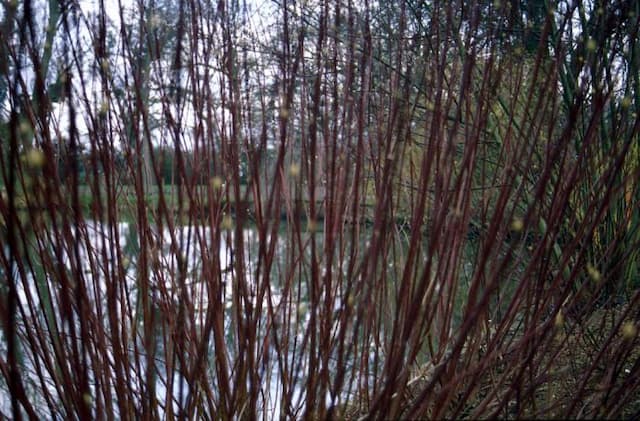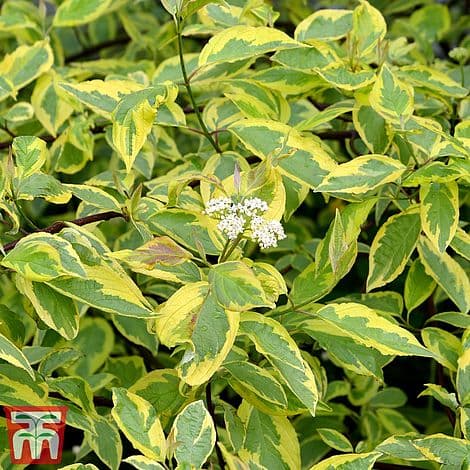Golden Cornelian Cherry Cornus mas 'Aurea' (v)











ABOUT
The Cornus mas 'Aurea', commonly referred to as the Golden Cornelian Cherry, is a visually striking variant of the traditional Cornelian Cherry. Its most notable feature is its vibrant, golden-yellow foliage, which shines brightly in the garden, particularly during the spring when the leaves first emerge. The leaves maintain this golden color throughout the growing season but may take on a greenish hue as they mature. Each leaf is oval to oblong in shape, bringing a lush texture to the plant's overall appearance. Before the foliage makes its grand debut, the Golden Cornelian Cherry heralds the arrival of spring with an exceptional floral display. Small, star-shaped flowers bloom in dense clusters, covering the branches. The blossoms exhibit a bright yellow hue, which complements the emerging golden leaves. This striking combination of the vibrant yellow flowers against the bare branches creates a delightful contrast in the early-season landscape. Following the floral spectacle, the plant produces edible fruit, which starts out as a green berry and ripens into a deep cherry-red color. The fruits are oval-shaped and attractive to both humans and wildlife, often used in preserves and liqueurs for their tart flavor. The bark of the Golden Cornelian Cherry further adds to its appeal, providing year-round interest with its exfoliating texture and a mixture of brown and gray hues. With its unique combination of ornamental features – from the stunning foliage and early blooms to the colorful fruit and textured bark – this plant is a multifaceted addition to any garden.
About this plant
 Names
NamesFamily
Cornaceae.
Synonyms
Golden Cornelian Cherry, Yellow Fruited Cornelian Cherry, Golden Cornelian Cherry Dogwood, Aurea Cornelian Cherry.
Common names
Cornus mas 'Aurea' (v).
 Toxicity
ToxicityTo humans
The common name for Cornus mas 'Aurea' is the Golden Cornelian Cherry. This plant is not commonly known for being toxic to humans. In fact, the fruit of the Cornelian Cherry is edible and is used in various culinary applications. However, like with any plant material, individual allergies or sensitivities could potentially cause reactions in some people. There are no widely recognized symptoms of poisoning from the Golden Cornelian Cherry because it is not considered poisonous.
To pets
The common name for Cornus mas 'Aurea' is the Golden Cornelian Cherry. This plant is generally considered to be non-toxic to pets such as dogs and cats. The fruit of the Cornelian Cherry is not toxic, and pets may consume it without any known adverse effects. However, as with any non-typical food item, ingestion of large quantities might cause mild gastrointestinal upset due to the novelty of the food, rather than toxicity. There are no specific symptoms of poisoning associated with the Golden Cornelian Cherry because it is not considered poisonous to pets.
 Characteristics
CharacteristicsLife cycle
Perennials
Foliage type
Deciduous
Color of leaves
Yellow
Flower color
Yellow
Height
15 feet (4.57 meters)
Spread
15 feet (4.57 meters)
Plant type
Shrub
Hardiness zones
5
Native area
Southern Europe
Benefits
 General Benefits
General Benefits- Attractive Ornamental Features: Cornelian cherry 'Aurea' is a highly ornamental plant due to its yellow leaves, small yellow flowers, and bright red fruit.
- Wildlife Attraction: The bright fruits attract birds, while the flowers can attract bees and other pollinators, aiding in garden biodiversity.
- Seasonal Interest: This plant provides year-round interest with flowers in spring, fruits in summer, and colorful foliage in fall.
- Drought Tolerance: Once established, Cornelian cherry 'Aurea' is tolerant of drought, making it suitable for xeriscaping or low-water gardens.
- Cold Resistance: It is hardy in a range of climates and can withstand cold temperatures, making it suitable for northern gardens.
- Edible Fruit: The fruits are edible and can be used to make preserves or eaten fresh, providing an additional yield from the garden.
- Compact Size: As a small tree or large shrub, it is well-suited for smaller gardens or can be used as part of a mixed border in larger landscapes.
 Medical Properties
Medical Properties- Antioxidant: Cornelian cherry (Cornus mas) fruit contains high levels of antioxidants which help in protecting the body from oxidative stress.
- Anti-inflammatory: Extracts of the fruit might have anti-inflammatory effects useful in reducing inflammation.
- Gastroprotective: It has been reported to have gastroprotective properties, potentially aiding in the protection of the gastrointestinal tract.
- Antidiabetic: Components within the fruit could help in managing blood sugar levels, making it potentially beneficial for individuals with diabetes.
- Antimicrobial: Certain extracts of Cornus mas have been noted to exhibit antimicrobial activity against some bacteria and fungi.
- Anticancer properties: There has been some suggestion that components in the fruit may have anticancer properties, although research is preliminary and more studies are needed.
- Cardiovascular health: There is limited evidence to suggest that Cornus mas might have a role in promoting heart health due to its antioxidative properties.
 Air-purifying Qualities
Air-purifying QualitiesThis plant is not specifically known for air purifying qualities.
 Other Uses
Other Uses- As a natural dye: The bark of Cornelian cherry can be used to extract a red dye for coloring fabric or wool.
- Woodworking material: Owing to its dense and hard timber, Cornelian cherry is often utilized in making tool handles and machine parts.
- Cultural symbolism: In some cultures, the plant is symbolic and used in ceremonies or traditional festivals to signify growth and vitality.
- Culinary garnishing: The bright red fruit of the Cornelian cherry can be used as an ornamental garnish for various dishes.
- Wildlife habitat: The shrub serves as a habitat and provides food for birds and wildlife, supporting biodiversity in the garden.
- Photography subject: With its vibrant yellow flowers and bright red fruits, the Cornelian cherry is a popular subject for garden and nature photographers.
- Teaching tool: Botany educators may use the plant to teach students about plant identification and the unique characteristics of the Cornus genus.
- Insect repellant: Some gardeners use the plant as a companion in the garden to deter certain pests due to its strong scent or physical properties.
- Soil stabilization: The root system of Cornelian cherry can help prevent soil erosion on slopes and banks.
- Cultural crafts: The wood or fruit of the plant may be used to create traditional crafts or artisanal objects in certain cultures.
Interesting Facts
 Feng Shui
Feng ShuiThe Cornelian Cherry is not used in Feng Shui practice.
 Zodiac Sign Compitability
Zodiac Sign CompitabilityThe Cornelian Cherry is not used in astrology practice.
 Plant Symbolism
Plant Symbolism- Eternal Nature: With its early spring flowers before the leaves, Cornus mas, commonly known as Cornelian cherry, symbolises renewal and the continuity of life.
- Vitality: The vibrant yellow flowers of the Aurea variety represent energy and vitality, a testament to the plant's early bloom and vigour.
- Protection: In some cultures, Cornelian cherry is thought to offer protection due to its hard wood and the longevity of the tree.
- Enlightenment: The bright, light-colored foliage of 'Aurea' can be associated with enlightenment, offering a visual contrast to darker surroundings.
 Water
WaterThe Cornelian Cherry Dogwood requires consistent moisture, especially during its establishment period and in dry conditions. During its first growing season, it should be watered deeply once a week, ensuring that the soil is moist but not waterlogged. Established plants will require less frequent watering, potentially every two to three weeks, depending on rainfall and soil conditions. Each watering session should provide the plant with one to two gallons of water, although exact amounts will differ based on soil type and weather.
 Light
LightThe Cornelian Cherry Dogwood thrives best in full sun to partial shade. It should be planted in a location where it can receive at least four to six hours of direct sunlight daily. Some afternoon shade is beneficial in areas with extremely hot summers, as it helps to prevent leaf scorch.
 Temperature
TemperatureThe Cornelian Cherry Dogwood is hardy and can tolerate a wide temperature range, from a winter low of around -30°F to summer highs that typically should not exceed 95°F. The ideal temperature for vigorous growth is between 60°F and 75°F. It is a resilient plant that can survive occasional temperature extremes outside of these ranges.
 Pruning
PruningPruning the Cornelian Cherry Dogwood is necessary to maintain its shape, remove any damaged or diseased branches, and encourage healthy growth. Prune the plant in late winter or early spring before new growth starts, removing up to one-third of the old wood to promote rejuvenation. Thinning out overcrowded branches every few years helps to improve air circulation and light penetration, which can reduce the risk of disease.
 Cleaning
CleaningAs needed
 Soil
SoilThe Cornelian Cherry Dogwood 'Aurea' thrives in moist, well-draining soil with an organically rich loam. For the best growth, the soil mix should include equal parts garden soil, compost or well-rotted manure, and sharp sand to improve drainage. The preferred soil pH is slightly acidic to neutral, ranging from 5.5 to 7.0.
 Repotting
RepottingThe Cornelian Cherry Dogwood 'Aurea' does not need to be repotted regularly as it is primarily grown outdoors. If grown in a pot, repot every 2-3 years during the dormant season to refresh the soil and provide room for growth.
 Humidity & Misting
Humidity & MistingThe Cornelian Cherry Dogwood 'Aurea' is adaptable to average outdoor humidity levels but does not tolerate prolonged dry air. It prefers a moderate humidity environment that generally aligns with its natural outdoor habitat.
 Suitable locations
Suitable locationsIndoor
Place near bright window; water regularly.
Outdoor
Full/partial sun; well-draining soil; mulch base.
Hardiness zone
4-8 USDA
 Life cycle
Life cycleThe life of Cornelian cherry 'Aurea' (Cornus mas 'Aurea') begins as a dormant seed that, upon experiencing the appropriate conditions of moisture and temperature, will germinate and emerge as a seedling. This seedling phase involves developing primary leaves and a root system to support subsequent growth. In its vegetative stage, 'Aurea' concentrates on producing a woody stem and branches, along with its characteristic golden-yellow foliage, enhancing photosynthesis and growth. As the plant matures, it enters the reproductive stage and starts flowering, typically in late winter to early spring, with small, bright yellow flowers before the leaves fully emerge. Following pollination, these flowers develop into distinctive, elongated red berries (drupes) during summer, which attract birds and other wildlife. The plant then enters a period of dormancy in the fall, where it conserves energy and prepares for the next growth cycle, repeating these stages annually once fully established.
 Propogation
PropogationPropogation time
Late winter to early spring
The most popular method for propagating Cornelian cherry (Cornus mas 'Aurea') is by semi-hardwood cuttings. This technique usually takes place in the late summer, when the current season's growth has started to harden. To perform this method, select healthy, semi-hardwood branches and cut 4 to 6-inch (10 to 15 cm) lengths, ensuring each cutting has at least two or three leaf nodes. The base of the cutting should be dipped in a rooting hormone to enhance root development. Next, plant the cuttings in a well-draining medium such as a mix of peat and perlite. Keep the medium moist but not waterlogged and place the cuttings in a warm location with indirect light. Rooting can take several weeks, after which the cuttings can be transplanted to individual pots or prepared garden beds to continue their growth.









